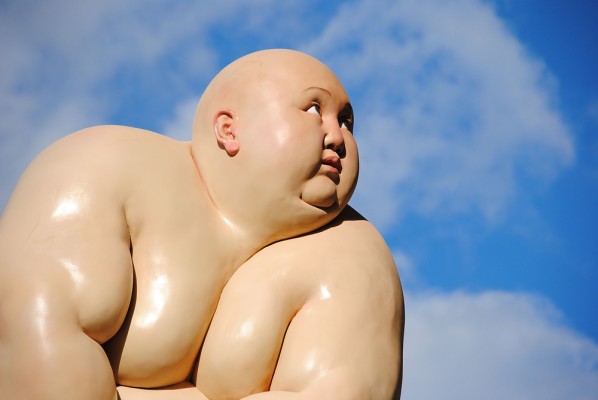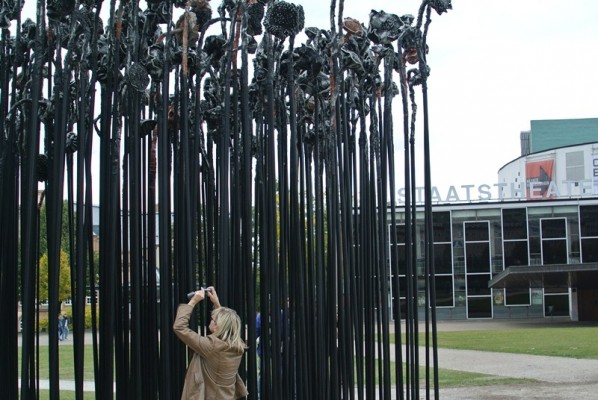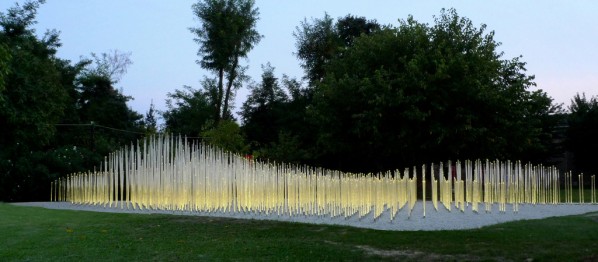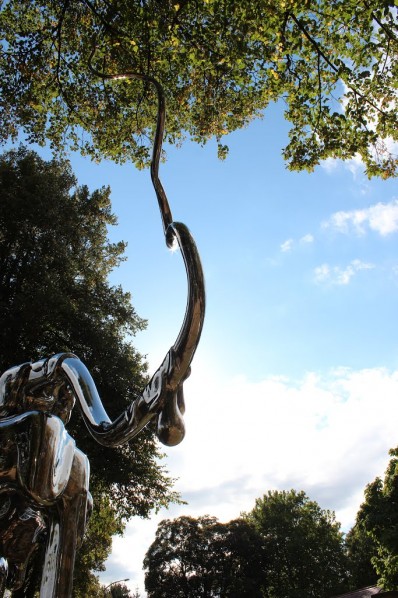
Mu Boyan, "Fix", Photo Courtesy Kunstfotografie & Kultur
Jointly organized by National Art Museum of China (NAMOC), China Central Academy of Fine Arts (CAFA), Free University of Berlin (FU), City Council of the City of Kassel and MHK, the “Chinese Public Art” in Kassel was grandly inaugurated in Kassel, the famous cultural city on October 2, 2012. The exhibition is the most important in the Chinese culture year 2012, in the field of visual art, and on January 10, 2013, it is the 100th day since the opening. During the last 100 days, the majority of German media have created numerous reports about the exhibition, and local people were constantly enthusiastic about it, for the overall new experiences from Chinese public art.
Reported by the German media: Kassel becomes a Chinese Town
Along with the opening of “Chinese Public Art in Kassel”, Kassel, a small town in the middle of Germany changes to be a “Chinese Town” (Christian Celente, “Neue Zürcher Zeitung”). 21 pieces of large-scale public art, specially created for Kassel by 19 Chinese artists, located in prominent positions meet audiences, it is loved by the local Kassel people, as well as attracting many viewers that have driven from different cities across Germany to appreciate the exhibition.
To the citizens of Kassel, this Chinese public art creates a sweet festival atmosphere, and many people take them as the continuation of Documenta 13. At first sight of the fabulous public art people are confused and some said “Is Documenta 13 still on?” Not until they know there are the works of “Chinese Public Art”, they sighed “They should feature in the Documenta”. In fact, this Chinese contemporary public art exhibition is unprecedented and warmly welcomed by the citizens of Kassel and wins public support of up to 76% on the networks, which is higher than some famous international contemporary exhibitions such as Documenta. During the 100 days of opening, Chinese art became the hot topic in Kassel city.
10 Navigations in the 100 days
The enthusiasm of the audiences to the exhibition originates from the fine works, as well as from the professional tours. To lead the audience to further enjoy the works, Free University of Berlin (FU) arranges volunteers to navigate the whole exhibition, which has rarely been seen in the past public art exhibitions. Every second weekend, graduate students from the School of Media and Cultural Management serve as volunteers for the tour in Kassel, though they drive 300kms from Berlin. There are two sections on each weekend, the first one is for the public in the morning, and the second one is dedicated to parents and children in the afternoon, there are about twenty people each time. And there have been 10 times in the 100 days since the opening. It has attracted companies interested in China to organize their staff to visit the exhibition, which is one of the best ways to learn about China. To the family with children from Kassel and the districts around it, the tour provides a good chance for art interaction between parents and children.

Xu Jiang, "Sunflower", 2012; Courtesy German Daily News
“Little dog Inja leading you to experience Chinese public art”
Alongside the volunteers from FU, a little dog named “Inja” is a special “star navigator” in the exhibition. While Documenta 13 launched an exhibition plate entitled “Dogumenta” designed for the puppy dog, under the impact of the “eco-feminist ideology” of Caroline Christov-Bakargiev, the curator, “North Hesse Rundschau” launches “Puppy Inja who leads you to experience Chinese public art”, during the 100 days since the opening, sometimes, Inja, a black and white puppy plays with other puppies in front of “Mountain of Penholder”(by Liu Liyun), a sculpture positioned on the bank of the Fulda River, sometimes in the middle of the thousands of small sculptures of Chinese mythological figures (“Xing Tian Wu/Totem” by Wu Jian’an) in Weinberg, its’ naive photos accompanied by its master’s humorous text are favored by readers, and sought after by a lot of “fans” on the network.
“The Chinese fat boards on the windowsill of the Western Art Museum”
Anyone who drives through the new art museum in Kassel, will be surprised to see a huge fat man on a ladder of up to 9 meters long peering into the window of the new museum. Not until they are close to it, do they realize that this is a giant sculpture. It is “Fix” (a works by Mu Boyan) which is seen as “the favorite work by audiences” by the local audiences in Kassel. This work is of an interesting plastic and in-depth thought, to attract RTL, the famous German literary TV station to produce a special report on it, and its images become popular in mainstream German media such as “DIE WELT ” and “Bild”, as well as widely circulated on the network. Media, critics and audiences have all kinds of speculation to the symbolic significance of the fat man and his climbing the ladder to peer inside the windows of the museum: is the fat man the symbol of the prosperity of Chinese economy and national power? Is the fat the irony to the consumer times of overproduction to the artist? Is the fat man seen to be a Chinese Buddha, peering at a Western art museum, reflecting the thought of the artist to Western art concept? All of the guesses give the works a rich and multilayered meaning, and the hundreds of handmade soap in the shape of fat man, designed by the artist were given to the Kassel citizens (it is a joke from the artist who invites the public of Kassel to “help the fat to lose weight” by washing their hands with the fat man soaps), adding to the works with public participation and interaction.

Chen Zhiguang “Chinesische L?wen”, Rathaus Courtesy German Daily News
Chinese lion and ants of “Jeff Koons’ style”
In front of the Kassel City Hall there are two stainless steel sculptures of Chinese lions (“Chinese Lions” by Chen Zhiguang, almost echoing with the golden lion, a marker of Kassel, standing at the entrance of the town hall, attracting and gathering citizens to watch and take photos. They are surprised to note that the colorful stainless steel ants which should be located on the base of the Chinese lions, emerge on the sidewalk in the center of the pedestrian street in the center of Kassel city.
These colorful stainless steel ants (Chen Zhiguang’s works “Migration Times”) are seen to be of “Jeff Koons’s style” by the critic, Christian Celente. As symbols of the industrious general public, the ants are placed in the street where people daily pass though, which can be regarded as a tribute to the general public itself. Maybe they feel so welcomed that five of them are stolen in the last 100 days. Thus the Chinese curator team negotiates with the City Council of Kassel City, asking them to ensure the security of each work.

Zhu Pei, YI-Garden, 2012; 40x10m
The “tops” of Chinese contemporary public art
“Chinese Public Art in Kassel” is the largest showcase of contemporary Chinese art in a public space outside of China, the fattest work is the “Chinese fat man” ( Mu Boyan’ works “Fix” of 25,800 Kg, the heaviest work in the exhibition is a Chen Wenling’s sculpture entitled “Chinese Landscape” (6100 Kg), the second one is Wang Mai’s installation entitled “Qi Xiang Lu Tai (Meteorological Carousel)” (6000 Kg); Zhu Pei’s installation “Yi Garden” takes the longest time to be set up, it took 16 days with workers hammering 1460 metal bases into the ground and connecting to the wire, and then the ground was topped with 40 tons of gravel, finally 2920 acrylic lamps were inserted into the bases (in accordance with the numbering sequence, each base has a plug into a fat and a thin pine respectively). Viewed from these figures, “Yi Garden” is the largest; the highest one is “Transformation” (9.2 meters), by Bi Heng, an artist born in the 1980s. The tall Chinese Fukatsu has a mystically cross-cultural dialogue and echo over a distance with Herkules, god of Kassel on the peak of William Highland; Liu Liyun’s “Mountain of Penholder” is not as heavy as a mountain, but the giant Chinese “brush” of 12 meters long is the largest component, which took 6 sturdy men a whole day to install it on the penholder through a forklift.

Chen Wenling, Chinese Lanscape, 2012; sculpture, 3.9x2.6x7.7m
The exhibition will be on view until March 10, 2013.
Duration: October 2, 2012 – March 10, 2013
Location: Kassel, Germany
Organizer: National Art Museum of China (NAMOC), China Central Academy of Fine Arts (CAFA), Free University of Berlin (FU) in cooperation with City Council of the City of Kassel and MHK
Curators: Fan Di’an, Yu Ding, Klaus Siebenhaar
?Text by Wang Wenting and Chen Kuangdi/CAFA
Translated by Chen Peihua and edited by Sue/CAFA ART INFO




























